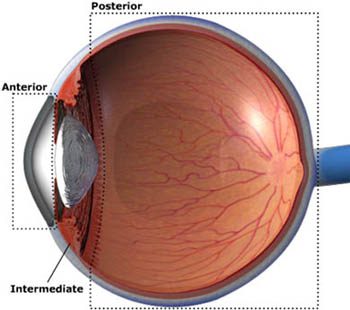What are the Types of Uveitis?
Uveitis is often grouped by the part of the uvea it affects. There are four types of uveitis:
- Anterior uveitis
- Intermediate uveitis
- Posterior uveitis
- Panuveitis

Anterior Uveitis affects the front of the eye. It is often called iritis because it mainly affects the area around the eye’s iris. Anterior uveitis is the most common kind of uveitis in children and adults making up 30–90% of all uveitis. It is usually acute (comes on quickly and lasts for less than six weeks) and is associated with eye pain, blurred vision, light sensitivity and redness. Intermediate Uveitis Intermediate uveitis is inflammation of the ciliary body, the front end of the retina, and the vitreous.
Intermediate Uveitis is the least common type of uveitis affecting young adults, making up only 1–12% of cases. It is also known as cyclitis, pars planitis or vitritis. Symptoms include floaters and blurry vision. It is not usually associated with pain. People with intermediate uveitis are more likely to have chronic inflammation. Chronic uveitis is defined as uveitis lasting longer than six weeks.
Posterior Uveitis is inflammation of the choroid, often involving the retina and optic nerve. and optic nerve. It is also known as choroiditis or retinitis. The optic nerve is the path that carries images from the retina to the brain. It can be seen in 5–30% of uveitis types. Generally it is chronic (long standing – can last weeks to months to years), recurrent (in which a patient goes between inflammation and a healthy eye) and affects both eyes. Posterior uveitis can cause vision loss. This type of uveitis can only be detected during an eye examination.
Panuveitis is when inflammation affects the entire uvea (iris, ciliary body, and choroid). It makes up 1–9% of cases. People with panuveitis may be more likely to experience vision loss. Symptoms include floaters, blurred or loss of vision.

